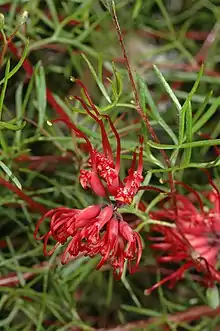Grevillea acropogon
Grevillea acropogon is a species of flowering plant in the family Proteaceae and is endemic to a restricted part of southwestern Western Australia. It is a prostrate to erect shrub with pinnatisect leaves with five to seven sharply-pointed lobes, and red flowers.
| Grevillea acropogon | |
|---|---|
 | |
| Scientific classification | |
| Kingdom: | Plantae |
| Clade: | Tracheophytes |
| Clade: | Angiosperms |
| Clade: | Eudicots |
| Order: | Proteales |
| Family: | Proteaceae |
| Genus: | Grevillea |
| Species: | G. acropogon |
| Binomial name | |
| Grevillea acropogon | |
Description
Grevillea acropogon is a prostrate to erect shrub that grows to a height of up to 1.8 m (5 ft 11 in) with softly-hairy young branchlets. The leaves are 15–25 mm (0.59–0.98 in) long and pinnatisect with five to seven lobes, sometimes the lobes further divided. The lobes are linear, sharply-pointed, 10–18 mm (0.39–0.71 in) long and 0.8–1.1 mm (0.031–0.043 in) wide. The flowers are red and arranged in groups of 18 to 24 on a flowering stem 12–17 mm (0.47–0.67 in) long, each flower on a pedicel 2.0–2.5 mm (0.079–0.098 in) long, the pistil 18–22 mm (0.71–0.87 in) long. Flowering occurs from June to September.[2][3]
Taxonomy
Grevillea acropogon was first formally described in 2000 by Robert Owen Makinson in the Flora of Australia based on material collected near Lake Unicup, west of Frankland, in 1996.[2][4] The specific epithet (acrobotrya) means "bearded at the end".[5]
Distribution and habitat
This grevillea is only known from the type location, where it grows in heathland in winter-wet situations.[2]
Conservation status
Grevillea acropogon is listed as "endangered" under the Australian Government Environment Protection and Biodiversity Conservation Act 1999 and as "Threatened Flora (Declared Rare Flora — Extant)" by the Department of Biodiversity, Conservation and Attractions. Only five individuals were known in 2015 but after a fenced enclosure was constructed the population increased to 275 in 2014. In 2009, 150 seedlings were introduced to a new site. The main threats to the species include damage by vehicles, drought, trampling by kangaroos and changes in hydrology.[3][6][7][8]
References
- "Grevillea acropogon". Australian Plant Census. Retrieved 1 November 2021.
- "Grevillea acropogon". Australian Biological Resources Study, Department of Agriculture, Water and the Environment: Canberra. Retrieved 1 November 2021.
- "Grevillea acropogon". FloraBase. Western Australian Government Department of Biodiversity, Conservation and Attractions.
- "Grevillea acropogon". APNI. Retrieved 1 November 2020.
- Sharr, Francis Aubi; George, Alex (2019). Western Australian Plant Names and Their Meanings (3rd ed.). Kardinya, WA: Four Gables Press. p. 126. ISBN 9780958034180.
- "Conservation advice - Grevillea acropogon" (PDF). Australian Government Department of Agriculture, Water and the Environment. Retrieved 1 November 2021.
- "Species Profile and Threats Database - Grevillea acropogon". Australian Government Department of Agriculture, Water and the Environment. Retrieved 1 November 2021.
- Sheather, Warren; Sheather, Gloria. "Grevillea acropogon". Australian Plants Society. Retrieved 1 November 2021.
